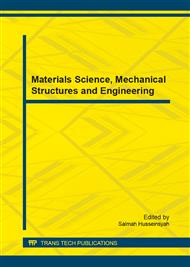p.135
p.140
p.146
p.150
p.154
p.160
p.167
p.171
p.175
Numerical Simulation and Experiment of Traveling Wave Piezoelectric De-Icing Technique
Abstract:
A new de-icing method is proposed based on the traveling wave piezoelectric theory, which is to remove residual ice on the fix points of the aircrafts. Testing equipment is designed as the following steps. Firstly, without piezoelectric ceramics, modal analysis of the testing skin which the dimension is 270×90×1.5 mm is completed to confirm the position of the piezoelectric ceramics. The piezoelectric ceramics are adhered to the testing skin with the maximum strain of the bending modes which the frequencies along X and Y direction are close to each other based on the above modal analysis. Then, the harmonic response analysis of the testing skin with ceramics is carried out to study the available excitation frequency in which the skin can travel looply. Finally, the equipments are fabricated to verify the numerical simulations. It is obtained that the excitation frequency to form the traveling wave is from 5099 to 5121 Hz. The input voltage passes 400 V can de-ice when the adhesive strength is set as 2 MPa in von Mises yield criterion. If the refrigerated ice is similar to the aerial ice, it is easily removed by the experimental equipments. However, it is required to further the research because this de-icing technique is still in its infancy.
Info:
Periodical:
Pages:
154-159
Citation:
Online since:
October 2014
Authors:
Price:
Сopyright:
© 2014 Trans Tech Publications Ltd. All Rights Reserved
Share:
Citation:


